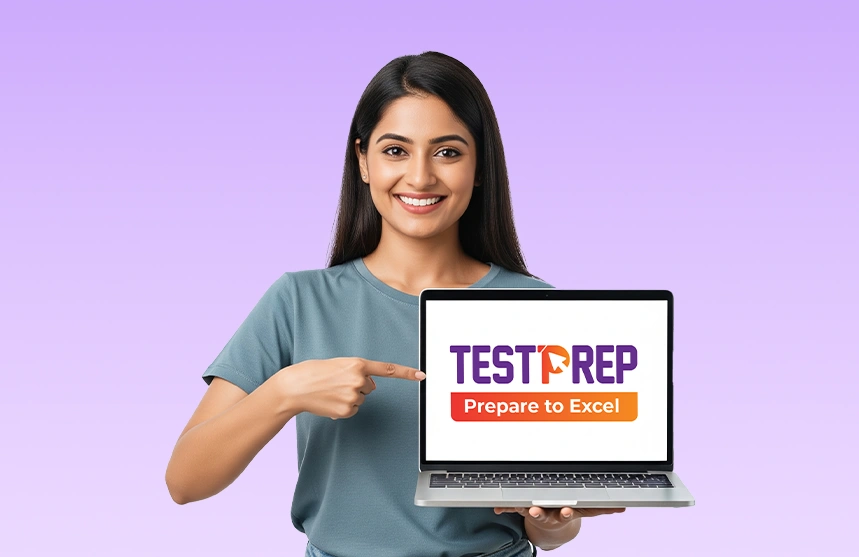GMAT Preparation Guide for Indian Students: Your Step-by-Step Roadmap to Success
Everything You Need to Know About GMAT

Want to enter one of the world’s top business schools? Trust us, we know: you are not just looking for an MBA degree. You aspire to get into the right program – one that propels your career forward, challenges your thinking, and positions you as a global leader. But before the case studies, internships, and networking nights come the oft-dreaded three words: the GMAT exam.
If you are considering pursuing business abroad, chances are that the GMAT Exam is already on your radar. As one of the most widely recognised exams to study abroad, this exam plays a pivotal role in helping top schools evaluate candidates. However, contrary to popular belief, GMAT requires more than just Math or English. It has a lot to do with thinking like a future business leader.
For instance, can you spot patterns quickly? Analyse the information conveyed and make data-driven decisions under pressure? Prioritise tasks with limited time? The GMAT exam can essentially be seen as a corporate boot camp in test form.
At MetaApply IE, we understand the journey to a top B-school is more than just clearing an exam. That’s why our GMAT support doesn’t just stop at the TestPrep – it extends to profile building, SOPs, interviews, and beyond. But before we get there, let’s dive deep into what GMAT is, why it matters, what the application process is, and how you can ace it – one percentile at a time!
What is GMAT & Why Should You Care?
GMAT is a globally recognised entrance exam used by leading business schools to assess candidates applying for MBA and other graduate management programs.
The full form of GMAT is Graduate Management Admission Test, and it has been the go-to exam for decades for one simple reason: it works the best. It is a standardised, computer-adaptive exam that doesn’t just test your existing knowledge; it evaluates how you think, adapt, and solve – core skills that every MBA student needs. The exam is accepted by over 7000 programs at more than 2300 key business institutions worldwide. It is valid for 5 years once taken, and is used primarily for MBA, MiM, and other business degrees.
GMAT has undergone a major revamp recently, and test-takers will get to experience the GMAT Focus Edition in 2025: a shorter, sharper version of the test designed to represent the evolving business landscape more accurately. Here’s what has changed:
Shorter Test Duration: 2 hours 15 minutes (vs. 3 hours+ earlier)
No Essay Section (goodbye, AWA!)
New Data Insights Section: This combines data sufficiency, interpretation, and critical reasoning.
More Control: You can choose the section order, review and change answers, and even select the scores you send to schools.
Bottom line? The GMAT exam is still challenging – but smarter, faster, and more flexible than before.
GMAT or GRE: Which One Should You Take?
If you feel torn between appearing for either GMAT or GRE, here’s the deal: both are accepted at most top business schools worldwide. However, the GMAT exam still holds the edge over GRE for MBA-specific programs and sends a clear signal that you are, in fact, serious about business. Here’s a quick look at what exactly makes these two different:
| Feature | GMAT | GRE |
|---|---|---|
| Focus | Business & Management Programs | Wider academic scope |
| Popularity (B-Schools) | Preferred by most MBA programs | Accepted by many, but not all |
| Quant Section | More focused, MBA-specific logic | Easier but more abstract |
| Essay Section | None (removed now) | Included (AWA) |
| Format | Business-context focused | General academic focus |
| Ideal For | MBA & B-School Applicants | Grad programs in multiple fields |
While both tests are widely accepted, GMAT is still preferred by a majority of global business schools, making it the more strategic choice for management-focused applicants.
But why is the GMAT exam preferred more? This exam is trusted by business schools for a reason – it evaluates the skills that matter most in a rigorous academic and professional environment. A strong GMAT score can not only enhance your application but may also increase your chances of receiving merit-based scholarships and standing out amidst a highly competitive applicant pool.
Breaking Down the GMAT Exam Pattern & Structure
The GMAT Exam Pattern is structured to test different competencies in a business aspirant through three main sections. Previously, there were four sections, including one on the Analytical Writing Assessment (AWA), but it has been removed from the new Focus Edition. Let’s decode the current exam pattern section by section so you know exactly what to expect:
1. Quantitative Reasoning (45 minutes)
This section tests high school-level math – but don’t be fooled. It’s not about those complex equations or calculations, but about strategic problem solving and data sufficiency. You will encounter arithmetic, algebra, and geometry, often wrapped in word problems that test business logic and time management.
Time: 62 minutes
Questions: 31
Key Skills Needed: Number sense, time-saving shortcuts, mental math accuracy, knowing when to skip and come back, etc.
2. Verbal Reasoning (45 minutes)
This section covers more than just the vocabulary; it’s essentially about thinking critically, but in English. Be it evaluating arguments, fixing grammar errors, or reading for tone, logic, and purpose – this section mirrors the kind of communication that you will need in B-school, and beyond.
Time: 65 minutes
Questions: 36
Key Focus Areas: Grammar and vocabulary, reading comprehension, critical reasoning, sentence correction, etc.
3. Data Insights (45 minutes)
This is the new section unique to the GMAT Focus Edition. It blends data interpretation, multi-source reasoning, and critical thinking into one powerful section. This has been designed to test real-world business aptitude – for instance, can you interpret dashboards, spot trends, and make decisions with messy, ambiguous data? Think Excel meets logic puzzles, and you are halfway there!
Time: 30 minutes
Questions: 12
Key Skills Tested:Data and graphical interpretation from multiple sources, multi-source reasoning, two-part analysis, etc.
GMAT Scoring: What’s a Good Score?
In the new Focus Edition, GMAT scores range from 205 to 805, with 805 being a perfect score. Each of the three sections contributes equally to the final score.
Above 655: Competitive for most top 50 B-schools
Above 700: Top 10% of test takers, great for M7 schools
760+: You are among the elites (think Harvard, Stanford level!)
That said, remember: B-schools look at your entire profile. A stellar GMAT score can certainly open many doors, but it cannot carry the whole application.
Registering for GMAT in 2025: A Step-by-Step Process
Getting started with registration for the GMAT Focus Edition in 2025 is a straightforward process – but timing and planning can make all the difference. Here’s a clear, step-by-step breakdown to help you register smoothly:
1. Visit the Official GMAT Website
Head over to mba.com, the official website for the GMAT exam. This is your go-to portal for all things GMAT, from registration and scheduling to prep resources.
2. Create or Log into Your Account
If you are new to the site, sign up with your basic personal and academic details. If you already have an account, simply log in to continue.
3. Select the GMAT Focus Edition
Choose the Focus Edition – this is the only version available for 2025 and beyond. You will be asked to choose your preferred testing mode:
- In-person at a test centre (ideal for those who prefer a controlled environment)
- Online at home (best for convenience and flexibility)
4. Pick Your Date and Time
Browse the available test dates and slots. It’s advisable to plan and register at least 2-3 months in advance, especially if you are targeting popular testing windows or specific B-school deadlines.
5. Pay the Exam Fee
The registration fee for the GMAT Focus Edition is $275 (approx. ₹22,800). You can pay using major credit/debit cards or other options available in your region.
6. Receive Confirmation
Once payment is successful, you will receive an email confirmation with your test details. You can also view and manage your appointment from your dashboard.
7. Start Your Preparation
With your test date locked in, it’s time to dive into prep mode. You can use this commitment as a motivator to build a study schedule and stick to it.
Need to reschedule or cancel?
You can make changes later if plans shift, but be mindful: rescheduling and cancellation fees apply, depending on how close the test date is. Check the official website for the latest policy and fee structure.
Expert Tips to Ace GMAT in 2025
GMAT isn’t a memory test where you have to rote down the answers and spill them at the exam centre. It’s more of a strategy game. And like any good game ever – the better your tactics are, the higher your score will be. To help you crack it, here are some expert-backed GMAT prep strategies:
1. Build a Study Schedule (And Stick to It)
Consistency should become your new best friend. No matter whether you have 8 months or 8 weeks left for the exam, design a realistic plan that lets you cover all sections, includes mocks, and still leaves scope for revisions. Don’t cram it all – build your knowledge base, time management skills, and stamina.
2. Practice with Official Materials
Use practice materials like the GMAT Official Guides, GMAT Focus mocks, and mba.com resources etc. These resources tend to reflect real test logic, difficulty levels, and trap patterns. Other third-party platforms are great, but remember to always loop back to the official questions for better preparation.
3. Time Yourself Religiously
The GMAT exam is essentially a race against the clock. You may know the answers to a lot, but poor time management can make you miss significant parts and lead to a low score despite ample preparation. To avoid such a situation, master pacing by taking timed practice tests, learning when to guess and when to move on, and building mental endurance to face the test.
4. Review Your Mistakes
Practicing problems is essential, but how you review them is where real growth happens. After all, every incorrect answer provides a window into your thought process. So, don’t just take up problems, solve them, and move on. Deconstruct each of them. Where did you go wrong and why? Did you misread, miscalculate, or misunderstand? Did you rush or second-guess yourself? Keep an error log, if possible, categorising mistakes by topic, and revisit them weekly. Over time, patterns will emerge – patterns you can correct before the D-Day.
5. Consider Expert Help
Even the best self-learners can hit plateaus. That’s where expert guidance can fast-track your progress. Consider enrolling in a structured GMAT prep program that understands the nuances of the GMAT exam. They can identify blind spots you’re too close to notice, customise study plans based on your baseline and goals, and offer strategic test-taking techniques that are hard to gather from books alone.
Remember, GMAT isn’t just a test of knowledge – it’s a test of performance, of your potential to become a business leader in the near future. The right support system can help you fine-tune both. So, where do you find this ‘right support system’ that we talk about? Right here, with MetaApply IE!
How MetaApply IE Can Help You with GMAT Prep & Beyond
We get it: the importance of GMAT is far beyond just ‘a good score’ for you. It’s your gateway to global B-schools, a future leadership role, and the life you have been working hard towards. At MetaApply IE, we don’t just prepare you for test day, but also for everything that comes after it. Here’s how we make it all happen:
Personalised GMAT TestPrep: Whether you are aiming for a 650 or a 750+, we tailor your prep strategy based on your target schools, your baseline performance, learning style, etc. Think of diagnostic tests, section-wise drills, and expert feedback – all built around you.
Hassle-Free Exam Registration: No more missing deadlines or dealing with confusing registration steps. We will guide you through the entire process – whether you choose to take the GMAT exam online or at a test centre – so you are free to focus on what matters the most (acing the exam!).
Program & University Shortlisting: Not sure where exactly to apply? We will help you shortlist the programs and B-schools that truly align with your career goals, profile, and budget – no generic rankings, just relevant, researched guidance.
End-to-End Application Support: From SOPs and LORs to resumes and interview prep, we help you build an application that tells your story with the impact it deserves. Our expert team knows what top B-schools look for – and how you can highlight your best self for them.
All-in-One Admission Help: Need help with scholarships? Study Visa guidance? Education loans, flights, or accommodation assistance? We have got you covered. Our constant support throughout the study abroad journey means you won’t need to stress about the small stuff while chasing the big dream!
The GMAT exam is your gateway to global opportunities in the business ecosystem, and beyond. With proper preparation, the right mindset, and consistent effort, you can approach it with confidence. At MetaApply IE, we are not just your TestPrep partner and mentor for GMAT – we are your dream team for admissions, and beyond.
Regardless of whether you are just beginning or are ready to finalise your applications, MetaApply IE is here to support you at every stage. Thousands of students across the globe have trusted us to turn their MBA aspirations into real, life-changing opportunities – will you be the next?
Ready to make your B-school dreams a reality?
Reach out to us at MetaApply IE today. Let’s get you in!
Frequently Asked Questions
The GMAT Focus Edition is the updated 2025 version of GMAT. It's shorter, removes the AWA (essay) section, includes a Data Insights section, and gives test-takers more flexibility in answering and scoring.
Most candidates need 2-6 months, depending on their baseline. Consistent study, timed practice, and reviewing mistakes are key. A personalised plan with expert help can accelerate your TestPrep!
Yes, the GMAT Focus Edition offers an online testing option. It’s ideal for those seeking flexibility and a familiar environment, though in-person testing is still available at designated centres.


















































